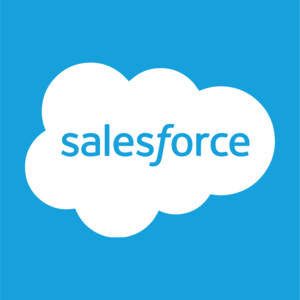
Salesforce (CRM)
Salesforce doesn’t excite us. Its sluggish sales growth shows demand is soft, a worrisome sign for investors in high-quality stocks.― StockStory Analyst Team
1. News
2. Summary
Why We Think Salesforce Will Underperform
With its cloud-based platform named after its stock ticker symbol CRM (Customer Relationship Management), Salesforce (NYSE:CRM) provides customer relationship management software that helps businesses connect with their customers across sales, service, marketing, and commerce.
- Operating profits increased over the last year as the company gained some leverage on its fixed costs and became more efficient
- Average ARR growth of 9.1% over the last year has disappointed, suggesting it’s had a hard time winning long-term deals and renewals
- A silver lining is that its disciplined cost controls and effective management have materialized in a strong operating margin, and its operating leverage amplified its profits over the last year


Salesforce’s quality doesn’t meet our expectations. We believe there are better businesses elsewhere.
Why There Are Better Opportunities Than Salesforce
High Quality
Investable
Underperform
Why There Are Better Opportunities Than Salesforce
At $265.19 per share, Salesforce trades at 5.6x forward price-to-sales. This multiple is lower than most software companies, but for good reason.
Cheap stocks can look like a great deal at first glance, but they can be value traps. They often have less earnings power, meaning there is more reliance on a re-rating to generate good returns - an unlikely scenario for low-quality companies.
3. Salesforce (CRM) Research Report: Q3 CY2025 Update
CRM software giant Salesforce (NYSE:CRM) met Wall Streets revenue expectations in Q3 CY2025, with sales up 8.6% year on year to $10.26 billion. The company expects next quarter’s revenue to be around $11.18 billion, coming in 2.5% above analysts’ estimates. Its non-GAAP profit of $3.25 per share was 13.6% above analysts’ consensus estimates.
Salesforce (CRM) Q3 CY2025 Highlights:
- Revenue: $10.26 billion vs analyst estimates of $10.28 billion (8.6% year-on-year growth, in line)
- Adjusted EPS: $3.25 vs analyst estimates of $2.86 (13.6% beat)
- Adjusted Operating Income: $3.64 billion vs analyst estimates of $3.51 billion (35.5% margin, 3.8% beat)
- Revenue Guidance for Q4 CY2025 is $11.18 billion at the midpoint, above analyst estimates of $10.9 billion
- Management raised its full-year Adjusted EPS guidance to $11.76 at the midpoint, a 3.6% increase
- Operating Margin: 21.3%, up from 20% in the same quarter last year
- Free Cash Flow Margin: 21.2%, up from 5.9% in the previous quarter
- Billings: $8.7 billion at quarter end, up 13.1% year on year
- Market Capitalization: $223.4 billion
Company Overview
With its cloud-based platform named after its stock ticker symbol CRM (Customer Relationship Management), Salesforce (NYSE:CRM) provides customer relationship management software that helps businesses connect with their customers across sales, service, marketing, and commerce.
Salesforce's Customer 360 platform serves as a digital command center for businesses, offering a unified view of customer data across multiple touchpoints. This single source of truth enables companies to deliver personalized experiences whether a customer is making a purchase, seeking support, or engaging with marketing campaigns. At its core, Salesforce allows companies to store customer information, track interactions, automate workflows, and gain insights through AI-powered analytics.
The company's portfolio includes specialized tools for different business functions. Sales Cloud helps sales teams manage leads and opportunities, while Service Cloud enables customer support agents to resolve issues efficiently across multiple channels. Marketing Cloud allows for personalized marketing campaigns, and Commerce Cloud powers digital storefronts. Additionally, Salesforce offers industry-specific solutions for sectors like healthcare, financial services, and manufacturing.
Salesforce operates on a subscription-based model, with customers paying regularly for access to its cloud-based software. This approach eliminates the need for businesses to maintain expensive on-premises systems. The company has built a robust ecosystem of third-party applications through its AppExchange marketplace, where developers can create and sell add-ons that extend the platform's functionality, similar to how smartphone app stores work.
4. Sales Software
Companies need to be able to interact with and sell to their customers as efficiently as possible. This reality coupled with the ongoing migration of enterprises to the cloud drives demand for cloud-based customer relationship management (CRM) software that integrates data analytics with sales and marketing functions.
Salesforce competes with Microsoft Dynamics 365 (NASDAQ: MSFT), Oracle CRM (NYSE: ORCL), SAP (NYSE: SAP), and HubSpot (NYSE: HUBS), along with numerous specialized CRM providers targeting specific industries or business functions.
5. Revenue Growth
A company’s long-term sales performance can indicate its overall quality. Even a bad business can shine for one or two quarters, but a top-tier one grows for years. Over the last five years, Salesforce grew its sales at a 14.7% compounded annual growth rate. Although this growth is acceptable on an absolute basis, it fell short of our standards for the software sector, which enjoys a number of secular tailwinds.
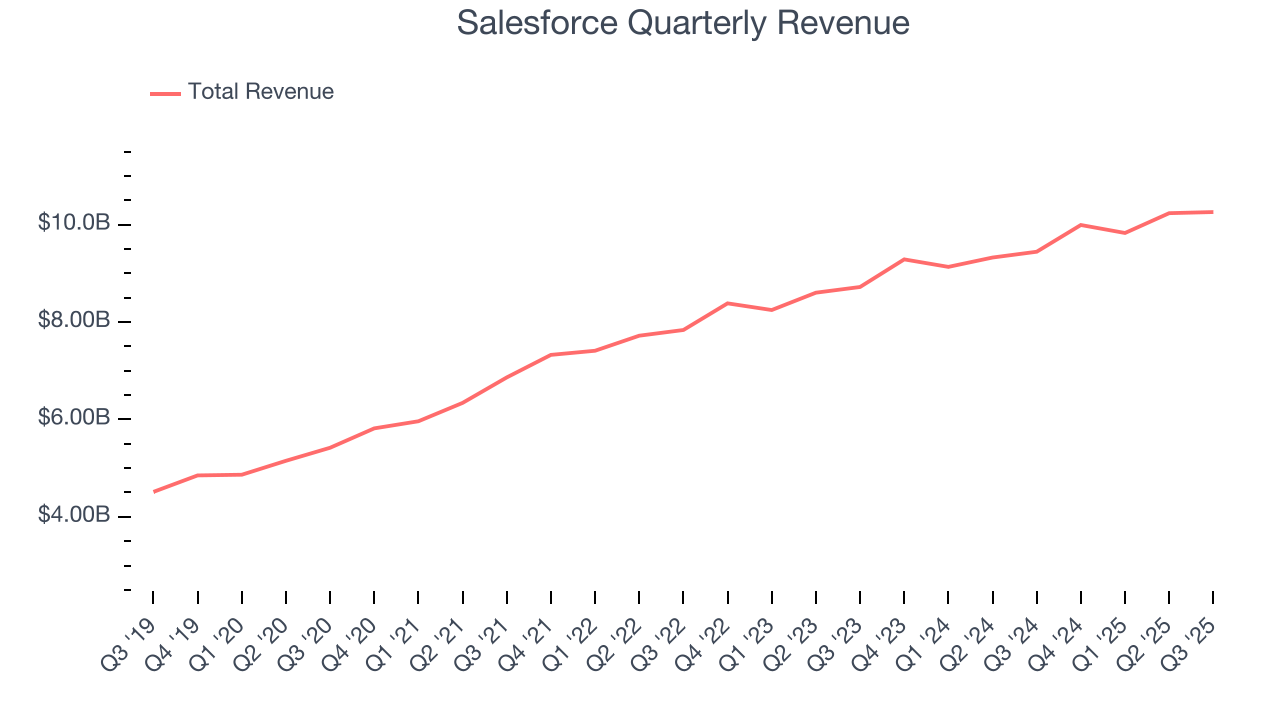
We at StockStory place the most emphasis on long-term growth, but within software, a half-decade historical view may miss recent innovations or disruptive industry trends. Salesforce’s recent performance shows its demand has slowed as its annualized revenue growth of 9% over the last two years was below its five-year trend. 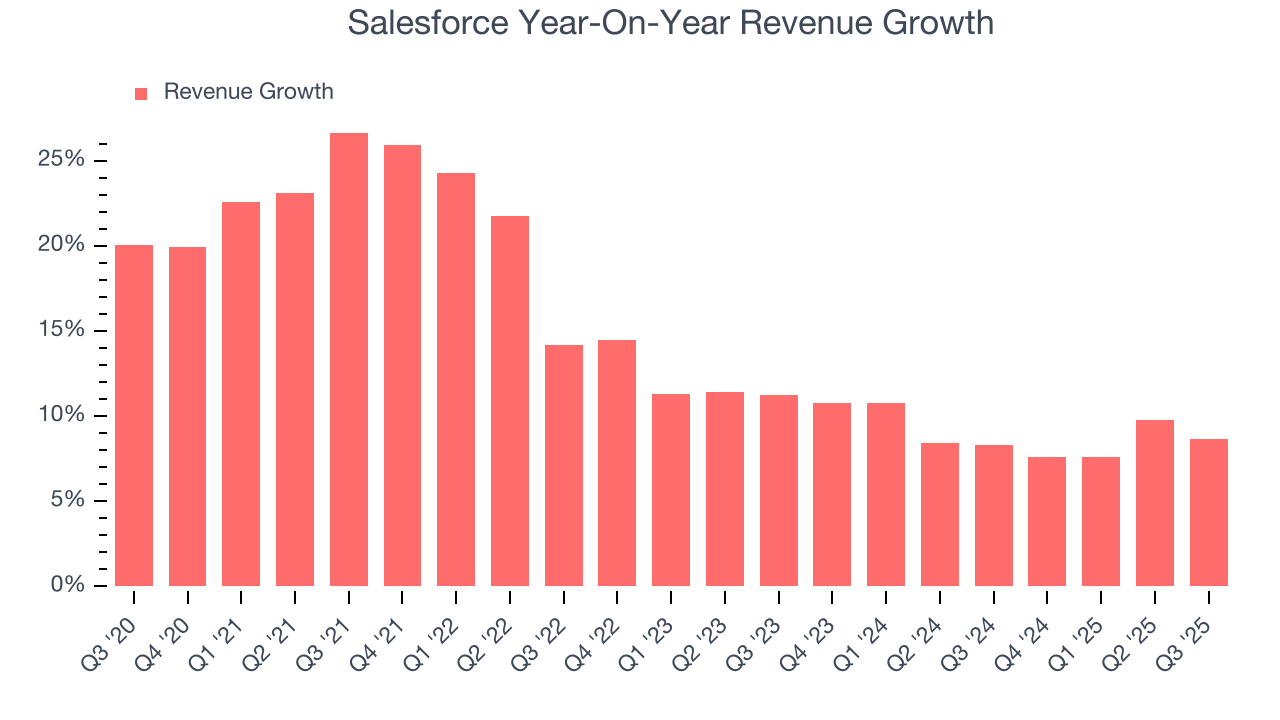
This quarter, Salesforce grew its revenue by 8.6% year on year, and its $10.26 billion of revenue was in line with Wall Street’s estimates. Company management is currently guiding for a 11.9% year-on-year increase in sales next quarter.
Looking further ahead, sell-side analysts expect revenue to grow 9% over the next 12 months, similar to its two-year rate. This projection doesn't excite us and indicates its newer products and services will not lead to better top-line performance yet.
6. Billings
Billings is a non-GAAP metric that is often called “cash revenue” because it shows how much money the company has collected from customers in a certain period. This is different from revenue, which must be recognized in pieces over the length of a contract.
Salesforce’s billings came in at $8.7 billion in Q3, and over the last four quarters, its growth was underwhelming as it averaged 10% year-on-year increases. This performance mirrored its total sales and suggests that increasing competition is causing challenges in acquiring/retaining customers. 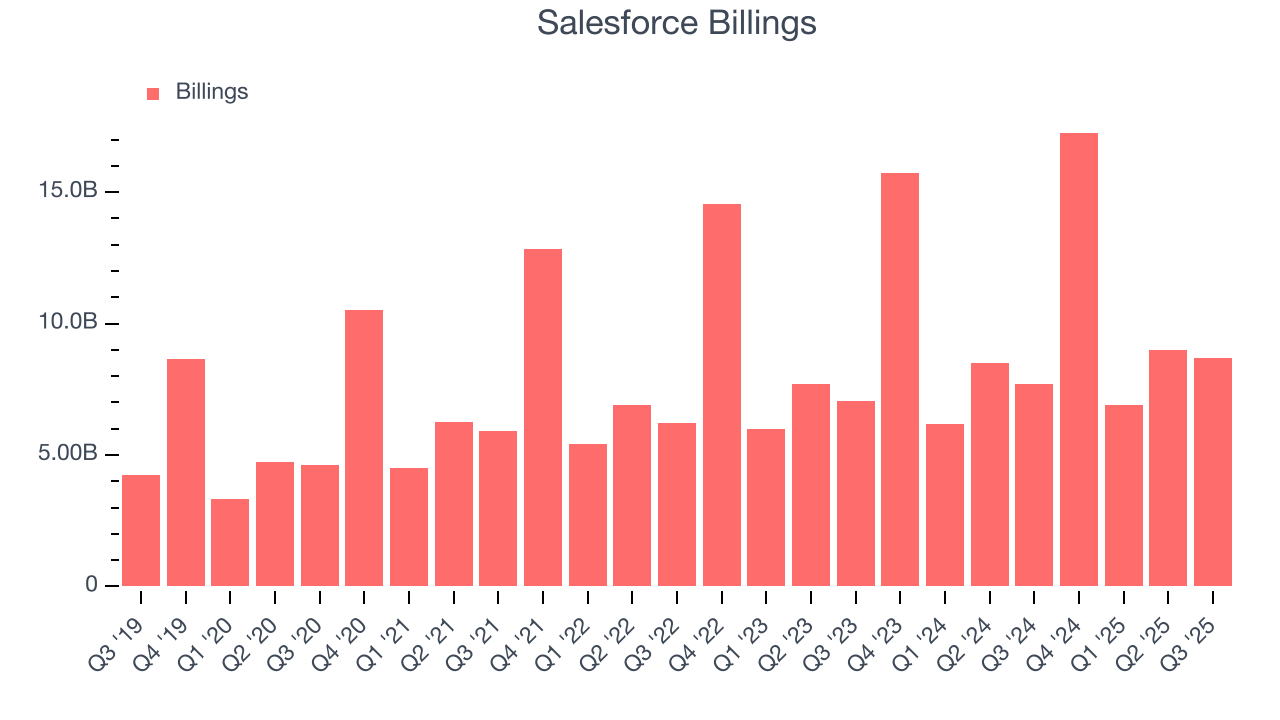
7. Customer Acquisition Efficiency
The customer acquisition cost (CAC) payback period represents the months required to recover the cost of acquiring a new customer. Essentially, it’s the break-even point for sales and marketing investments. A shorter CAC payback period is ideal, as it implies better returns on investment and business scalability.
It’s relatively expensive for Salesforce to acquire new customers as its CAC payback period checked in at 137.2 months this quarter. The company’s slow recovery of its sales and marketing expenses indicates it operates in a highly competitive market and must invest to stand out, even if the return on that investment is low.
8. Gross Margin & Pricing Power
For software companies like Salesforce, gross profit tells us how much money remains after paying for the base cost of products and services (typically servers, licenses, and certain personnel). These costs are usually low as a percentage of revenue, explaining why software is more lucrative than other sectors.
Salesforce’s robust unit economics are better than the broader software industry, an output of its asset-lite business model and pricing power. They also enable the company to fund large investments in new products and sales during periods of rapid growth to achieve higher profits in the future. As you can see below, it averaged an excellent 77.7% gross margin over the last year. That means Salesforce only paid its providers $22.27 for every $100 in revenue.
The market not only cares about gross margin levels but also how they change over time because expansion creates firepower for profitability and free cash generation. Salesforce has seen gross margins improve by 2.7 percentage points over the last 2 year, which is very good in the software space.
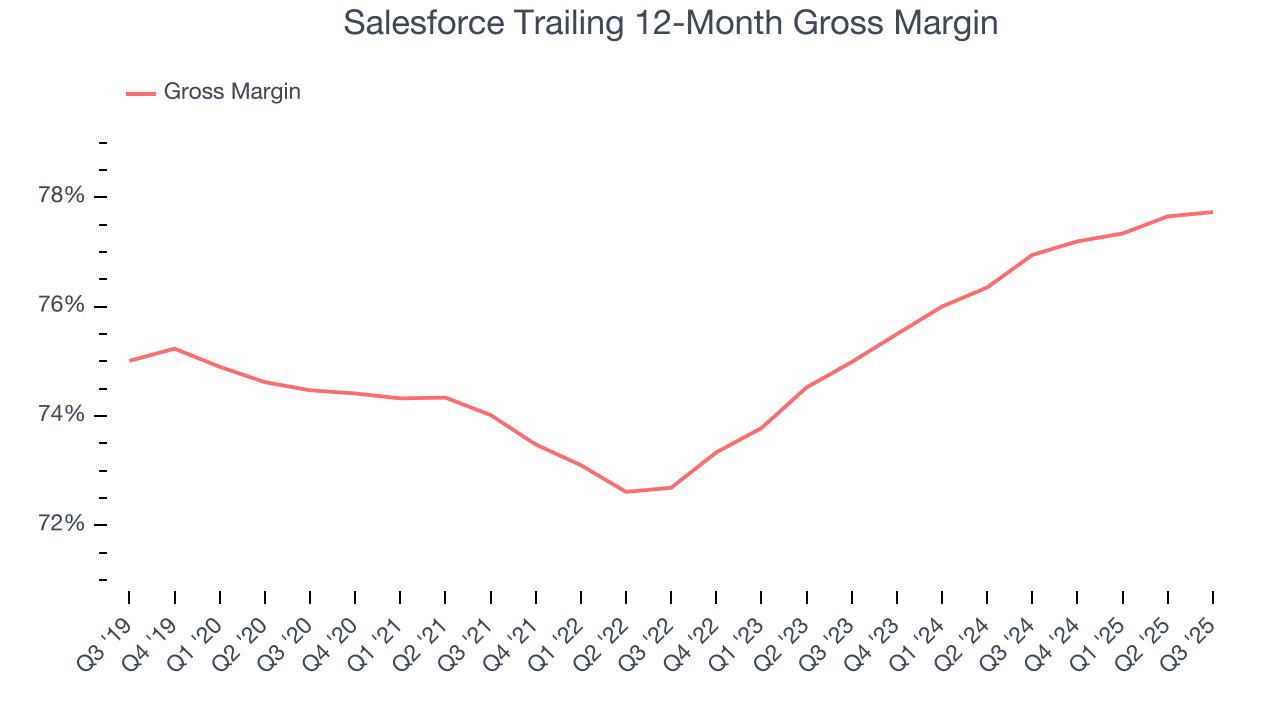
Salesforce produced a 78% gross profit margin in Q3, in line with the same quarter last year. Zooming out, the company’s full-year margin has remained steady over the past 12 months, suggesting its input costs have been stable and it isn’t under pressure to lower prices.
9. Operating Margin
Many software businesses adjust their profits for stock-based compensation (SBC), but we prioritize GAAP operating margin because SBC is a real expense used to attract and retain engineering and sales talent. This is one of the best measures of profitability because it shows how much money a company takes home after developing, marketing, and selling its products.
Salesforce has been a well-oiled machine over the last year. It demonstrated elite profitability for a software business, boasting an average operating margin of 20.5%. This result isn’t surprising as its high gross margin gives it a favorable starting point.
Looking at the trend in its profitability, Salesforce’s operating margin rose by 1.7 percentage points over the last two years, as its sales growth gave it operating leverage.

This quarter, Salesforce generated an operating margin profit margin of 21.3%, up 1.3 percentage points year on year. The increase was encouraging, and because its operating margin rose more than its gross margin, we can infer it was more efficient with expenses such as marketing, R&D, and administrative overhead.
10. Cash Is King
If you’ve followed StockStory for a while, you know we emphasize free cash flow. Why, you ask? We believe that in the end, cash is king, and you can’t use accounting profits to pay the bills.
Salesforce has shown terrific cash profitability, driven by its lucrative business model that enables it to reinvest, return capital to investors, and stay ahead of the competition while maintaining an ample cushion. The company’s free cash flow margin was among the best in the software sector, averaging an eye-popping 32% over the last year.
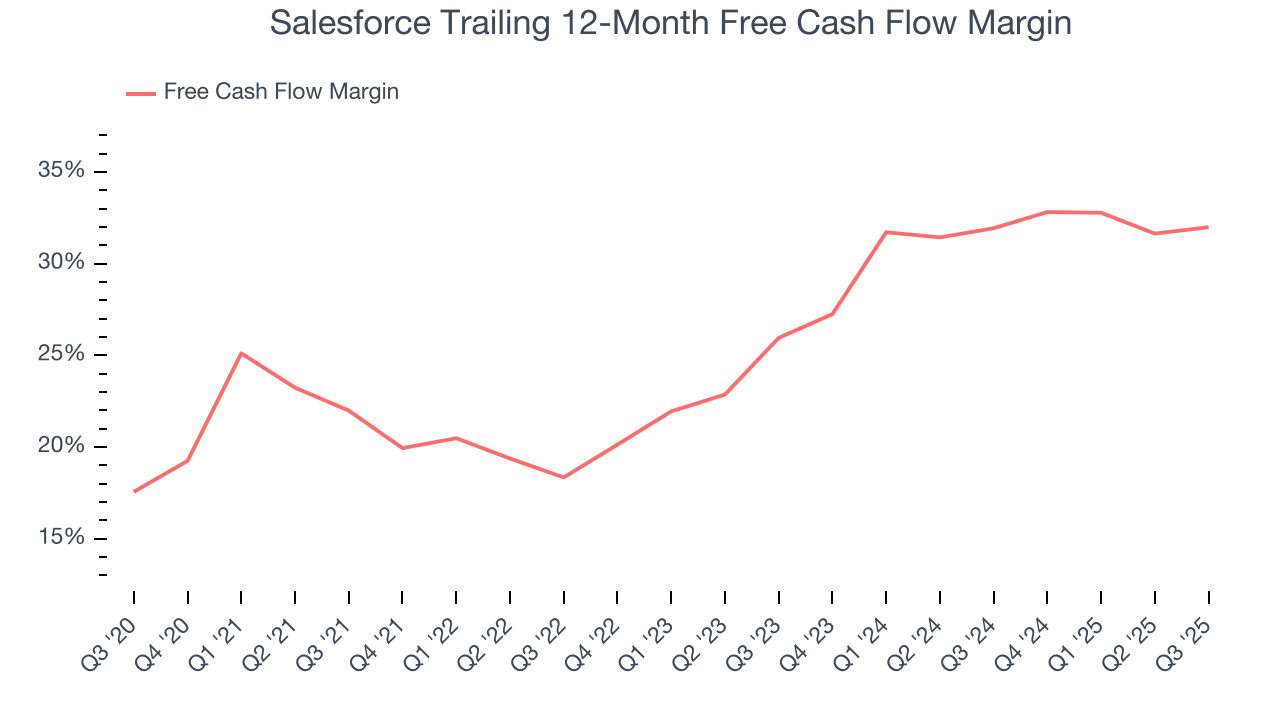
Salesforce’s free cash flow clocked in at $2.18 billion in Q3, equivalent to a 21.2% margin. This result was good as its margin was 2.4 percentage points higher than in the same quarter last year, but we wouldn’t read too much into the short term because investment needs can be seasonal, leading to temporary swings. Long-term trends carry greater meaning.
Over the next year, analysts predict Salesforce’s cash conversion will slightly improve. Their consensus estimates imply its free cash flow margin of 32% for the last 12 months will increase to 34%, giving it more flexibility for investments, share buybacks, and dividends.
11. Balance Sheet Assessment
Big corporations like Salesforce are attractive to many investors in times of instability thanks to their fortress balance sheets that buffer pockets of soft demand.
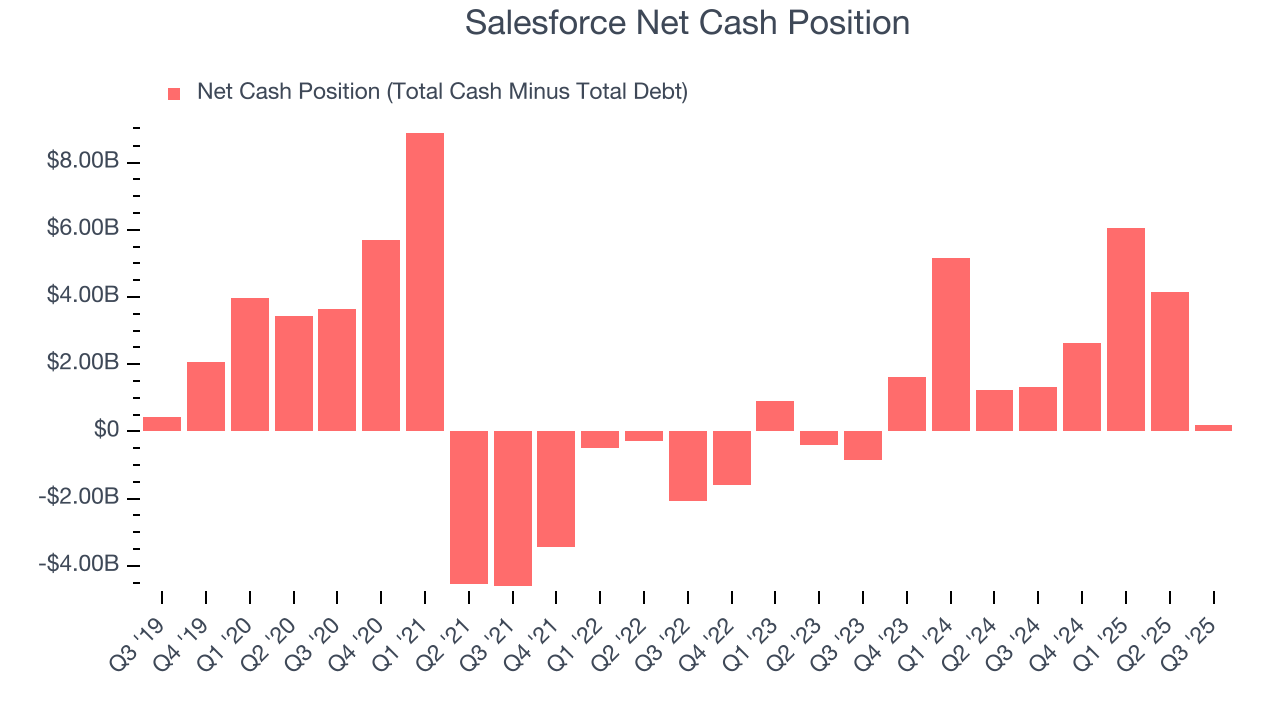
Salesforce is a profitable, well-capitalized company with $11.32 billion of cash and $11.14 billion of debt on its balance sheet. This $184 million net cash position gives it the freedom to borrow money, return capital to shareholders, or invest in growth initiatives. Leverage is not an issue here.
12. Key Takeaways from Salesforce’s Q3 Results
We were impressed by Salesforce’s optimistic full-year EPS guidance, which blew past analysts’ expectations. We were also glad its billings outperformed Wall Street’s estimates. On the other hand, its revenue was in line. Overall, this print had some key positives. The stock traded up 4% to $248.66 immediately following the results.
13. Is Now The Time To Buy Salesforce?
Updated: December 24, 2025 at 9:01 PM EST
We think that the latest earnings result is only one piece of the bigger puzzle. If you’re deciding whether to own Salesforce, you should also grasp the company’s longer-term business quality and valuation.
Salesforce isn’t a terrible business, but it isn’t one of our picks. To begin with, its revenue growth was a little slower over the last five years, and analysts expect its demand to deteriorate over the next 12 months. And while its impressive operating margins show it has a highly efficient business model, the downside is its expanding operating margin shows it’s becoming more efficient at building and selling its software. On top of that, its ARR has disappointed and shows the company is having difficulty retaining customers and their spending.
Salesforce’s price-to-sales ratio based on the next 12 months is 5.6x. Investors with a higher risk tolerance might like the company, but we think the potential downside is too great. We're pretty confident there are superior stocks to buy right now.
Wall Street analysts have a consensus one-year price target of $330.06 on the company (compared to the current share price of $265.19).
Although the price target is bullish, readers should exercise caution because analysts tend to be overly optimistic. The firms they work for, often big banks, have relationships with companies that extend into fundraising, M&A advisory, and other rewarding business lines. As a result, they typically hesitate to say bad things for fear they will lose out. We at StockStory do not suffer from such conflicts of interest, so we’ll always tell it like it is.








